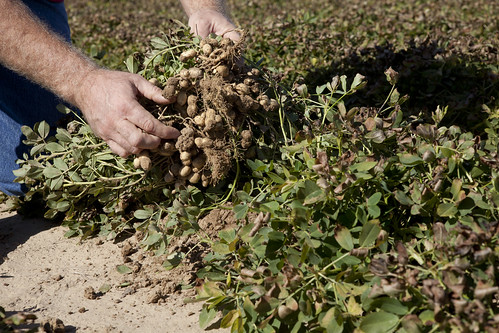Peanut harvest seeing the same slow progress as many crops across state
By Ryan McGeeney
U of A System Division of Agriculture
Nov. 9, 2018
Fast Facts:
- Peanuts, once dug but not yet thrashed, may be more vulnerable to wet weather
- About half of Arkansas peanut acres currently harvested
(591 words)
(Download this story in MS Word format here.)
LITTLE ROCK – Consider the peanut: more legume than nut, more row crop than bush or tree. And in Arkansas agriculture, it has often been more specialty crop than practical rotation crop for large-scale, commercial growers.
In 2010, however, Arkansas growers began to plant peanuts in sizeable acreages, and have increased steadily much of the time since. Approximately 30,000 acres were planted in 2017, dropping about 3,700 acres in 2018, according to the Farm Service Agency, as rising cotton prices proved increasingly attractive for growers in Arkansas and elsewhere.
Now, as periodic rains continue to dampen the state well into the fall, the state’s peanut growers are facing the same struggles as most other producers: Waiting out the rain, hoping for enough sunny days in a row to further the progress of harvest.
Travis Faske, extension plant pathologist and acting peanut agronomist for the University of Arkansas System Division of Agriculture, said the somewhat complicated nature of harvesting peanuts may make the crop especially vulnerable to the elements.
“With peanuts, we’ve got that extra step,” Faske said. “You dig them out, allow them to dry a bit, then come back to thrash them. There’s a three- to five-day window to allow the peanuts to dry out above ground. If it rains during that window, it just delays things more.”
Peanuts exposed to rainy conditions, once dug but not yet thrashed for an extended period of time, may be vulnerable to the formation of mold and increased percentage of pod rot. While that could affect sales for peanuts being sold as “fresh market” items, it tends not to affect peanuts being sold for use in peanut butter, as are most of Arkansas-grown peanuts, Faske said.
“This has been one of the worst harvest seasons growers have seen, if they’re new to peanuts,” Faske said. “We’ll have a pretty good idea of their interest in peanuts after this season.”
As of Nov. 4, Arkansas growers had harvested approximately 53 percent of all peanuts planted in the state, significantly behind the 83 percent harvest rate at this point in last year’s season, according to the USDA’s National Agricultural Statistics Service.
“The frequency of rainfall has really slowed things down,” Faske said. “We would be right in line with where we’d normally be, had we not had that rain at the end of September, and throughout October.”
Faske said that as temperatures continue to drop, Arkansas growers may be faced with a tough choice.
“We’re running the risk of peanuts freezing in the field,” he said. “If it does freeze, that will speed up this harvest window. “If 50 percent of the vines freeze, the pegs become loose, which means the grower probably needs to harvest within seven days. A freeze is likely to happen this month, meaning the growers are likely going to get into crunch time, sooner than later.”
The current market for peanuts is also something of a seesaw, sandwiched between large amounts of harvested peanuts already in storage, and drastic reductions in production from major peanut produces such as Georgia, which dropped from about 800,000 peanut acres to 650,000, and may see even greater reduction in production due to hurricane weather events.
“If Georgia has a substantial number of acres that aren’t harvested, or destroyed by one of these recent hurricanes, that could impact the futures market,” Faske said. “Arkansas isn’t the only state impacted by bad weather this year.”
To learn about peanuts in Arkansas, contact your local Cooperative Extension Service agent or visit www.uaex.uada.edu. Follow us on Twitter at @AR_Extension.
About the Division of Agriculture
The University of Arkansas System Division of Agriculture’s mission is to strengthen agriculture, communities, and families by connecting trusted research to the adoption of best practices. Through the Agricultural Experiment Station and the Cooperative Extension Service, the Division of Agriculture conducts research and extension work within the nation’s historic land grant education system.
The Division of Agriculture is one of 20 entities within the University of Arkansas System. It has offices in all 75 counties in Arkansas and faculty on five system campuses.
Pursuant to 7 CFR § 15.3, the University of Arkansas System Division of Agriculture offers all its Extension and Research programs and services (including employment) without regard to race, color, sex, national origin, religion, age, disability, marital or veteran status, genetic information, sexual preference, pregnancy or any other legally protected status, and is an equal opportunity institution.
# # #
Media Contact: Ryan McGeeney
Communication Services
U of A System Division of Agriculture
Cooperative Extension Service
(501) 671-2120
rmcgeeney@uada.edu
